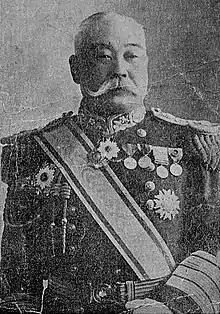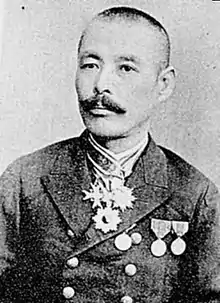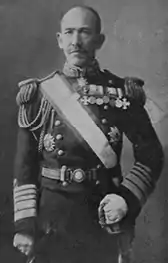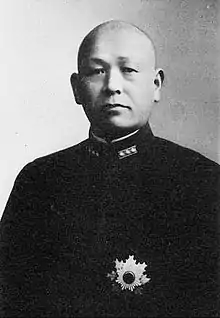Yokosuka Naval District
Yokosuka Naval District (横須賀鎮守府, Yokosuka chinjufu) was the first of four main administrative districts of the pre-war Imperial Japanese Navy. Its territory included Tokyo Bay and the Pacific coasts of central and northern Honshū from the Kii Peninsula to Shimokita Peninsula. Its headquarters, along with most of its installations, including the Yokosuka Naval Arsenal, were located in the city of Yokosuka, which constituted the Yokosuka Naval Base.

History
The location of Yokosuka at the entrance to strategic Tokyo Bay was recognized of critical importance by the Tokugawa shogunate and early Meiji government. In 1866, the Tokugawa shogunate government established the Yokosuka Seisakusho, a military arsenal and naval base, with the help of foreign engineers, including the French naval architect Léonce Verny. The new facility was intended to produce modern, western-style warships and equipment for the Tokugawa navy. After the Boshin War and the Meiji Restoration, the new Meiji government took over control of the facility in 1871, renaming it the Yokosuka Zosenjo (Yokosuka Shipyards). In August 1876, the Imperial Japanese Navy was organized into eastern and a western strategic zones, with the eastern zone Tōkai chinjufu (東海鎮守府) based at Yokosuka, and the western zone Saikai chinjufu (西海鎮守府) based at Nagasaki. However, for ease of communications with naval headquarters in Tokyo, the Tōkai Naval District was relocated to Yokohama in September 1876.
With the reorganization of the Imperial Japanese Navy in April 1886, Japan was divided into five naval districts for recruiting and supply, and the headquarters for the Tokai Naval District was relocated back to Yokosuka, becoming the Yokosuka Naval District, and the Yokosuka Naval Arsenal was placed under its command. As with all naval districts, it was under the direction of the Navy Ministry during peacetime, and came under the command of the fleets stationed within the district in time of war.[1] A Bureau of Torpedo Warfare was established at Yokusuka in June 1885. In a further administrative re-organization of the Japanese Navy in 1889, Yokosuka was designated as the “First Naval District” (第一海軍区, dai-ichi kaigunku), and its harbor was dredged, a breakwater extended and docking facilities for warships were increased. A Bureau of Mine Warfare was also established. In 1893, schools for naval mechanical engineering, torpedo warfare and naval artillery were established. Schools for naval engineering, and for mine warfare followed in 1907 and a naval medical center in 1908. Naval aviation facilities were established in June 1912, followed by a wireless communications facility in April 1913.
On January 14, 1917, the armoured cruiser Tsukuba exploded and sank in Yokosuka port in an accident. The Naval Construction Department was established in 1921. In June 1930, a Naval Communications School was established, but the Naval Mine School was made independent of the naval district. A Naval Aviation School was established in April 1934.
Pacific war
At the time of the attack on Pearl Harbor in 1941, Yokosuka Naval District encompassed the following [2]
- Yokosuka Naval District HQ
- Yokosuka Naval Base
- Yokosuka Naval Base HQ
- Yokosuka Communications Center
- Yokosuka Supply Department
- Accounting Department
- Construction Department
- Ports & Docks Unit
- Yokosuka Naval Arsenal
- Naval Hospital
- Naval Prison
- Naval Fuel Depot
- Yokosuka Base Garrison
- Yokosuka 1st Naval Barracks[3]
- Yokosuka 2nd Naval Barracks[3]
- Yokosuka Special Naval Landing Forces
- Yokosuka Submarine Base
- Yokosuka Security Squadron[3]
- Auxiliary Cruiser Noshiro Maru, Auxiliary gunboat Shoei Maru, Meiji Maru No. 1
- Yokosuka Local Defence Squadron[3]
- Minesweeper Division 25; Auxiliary minesweeper Misago Maru No. 1, Misago Maru No. 3, Kongo Maru No. 2, Naruo Maru, Shintohoku Maru, Togo Maru
- Minesweeper Division 26; Auxiliary minesweeper Banshu Maru No. 18, Keijin Maru No. 1, Keijin Maru No. 2, Showa Maru No. 10,
- Submarine tender Komahashi[3]
- Destroyer Sawakaze, Yūgumo[3]
- Submarine Chaser No. 22, No. 23[3]
- Yokosuka Naval Air Group (Oppama)
- Tateyama Naval Air Group
- Kisarazu Naval Air Group
- 11th Combined Air Group (Training)
- Kasumigaura Naval Air Group
- Tsukuba Naval Air Group
- Yatabe Naval Air Group
- Hyakurihara Naval Air Group (Ibaraki Pref)
- Kashima Naval Air Group
- Suzuka Naval Air Group
- Tsuchiura Naval Air Group
- Yokosuka Naval Base
In May 1945, Michitaro Tozuka became the final commander of the Yokosuka Naval District.[4] Yokosuka was bombed by United States Navy and United States Army Air Forces aircraft in the final stages of the Pacific War, most notably during the attack on Yokosuka on 18 July 1945, but many of its facilities were captured intact by the Allied forces. The Yokosuka area came under occupation by American forces during the occupation of Japan, and most of the facilities of the former Yokosuka Naval District were inherited by the United States 7th Fleet and are now known as United States Fleet Activities Yokosuka. A small portion of the area continues to be used by the modern post-war Japanese Maritime Self-Defense Force and are now known as JMSDF Yokosuka Naval Base, which has preserved a portion of the original red brick gates.
List of commanders
Commander of Tōkai Naval District
| No. | Name | Portrait | Rank | Term of Office | |
|---|---|---|---|---|---|
| Start | End | ||||
| 1 | Itō Sukemaro |  |
Vice Admiral | 5 September 1876 | 5 March 1880 |
| 2 | Abo Kiyoyasu |  |
Rear Admiral | 5 March 1880 | 4 December 1880 |
| 3 | Nakamuta Kuranosuke |  |
Vice Admiral | 4 December 1880 | 17 June 1881 |
| 4 | Nire Kagenori |  |
Vice Admiral | 17 June 1881 | 12 October 1882 |
| 5 | Nakamuta Kuranosuke |  |
Vice Admiral | 12 October 1882 | 14 December 1884 |
Director of Yokusuka Naval District
| No. | Name | Portrait | Rank | Term of Office | |
|---|---|---|---|---|---|
| Start | End | ||||
| 1 | Nakamuta Kuranosuke |  |
Vice Admiral | 14 December 1884 | 26 April 1886 |
Commanding officers of Yokusuka Naval District
| No. | Name | Portrait | Rank | Term of Office | |
|---|---|---|---|---|---|
| Start | End | ||||
| 1 | Nakamuta Kuranosuke |  |
Vice Admiral | 26 April 1886 | 8 March 1889 |
| 2 | Nire Kagenori |  |
Vice Admiral | 8 March 1889 | 17 June 1891 |
| 3 | Akamatsu Noriyoshi |  |
Vice Admiral | 17 June 1891 | 12 December 1892 |
| 4 | Itō Sukeyuki |  |
Vice Admiral | 12 December 1892 | 20 May 1893 |
| 5 | Inoue Yoshika |  |
Vice Admiral | 20 May 1893 | 16 February 1895 |
| 6 | Aiura Norimichi |  |
Vice Admiral | 16 February 1895 | 9 April 1897 |
| 7 | Tsuboi Kōzō |  |
Vice Admiral | 9 April 1897 | 30 January 1898 |
| 8 | Samejima Kazunori |  |
Vice Admiral | 1 February 1898 | 19 January 1899 |
| 9 | Aiura Norimichi |  |
Vice Admiral | 19 January 1899 | 20 May 1900 |
| 10 | Inoue Yoshika |  |
Vice Admiral
Admiral (after 12 December 1901 |
20 May 1900 | 20 December 1905 |
| 11 | Kamimura Hikonojō |  |
Vice Admiral | 20 December 1905 | 1 December 1909 |
| 12 | Uryū Sotokichi |  |
Vice Admiral
Admiral (after 16 October 1912) |
1 December 1909 | 1 December 1912 |
| 13 | Hikohachi Yamada |  |
Vice Admiral | 1 December 1912 | 29 May 1914 |
| 14 | Ijichi Suetaka | Vice Admiral | 29 May 1914 | 23 September 1915 | |
| 15 | Fujii Kōichi |  |
Vice Admiral | 23 September 1915 | 1 December 1916 |
| 16 | Prince Higashifushimi Yorihito |  |
Vice Admiral | 1 December 1916 | 1 December 1917 |
| 17 | Nawa Matahachirō |  |
Vice Admiral
Admiral (after 2 July 1918) |
1 December 1917 | 24 August 1920 |
| 18 | Yamaya Tanin |  |
Admiral | 24 August 1920 | 27 July 1922 |
| 19 | Takarabe Takeshi |  |
Admiral | 27 July 1922 | 15 May 1923 |
| 20 | Nomaguchi Kaneo | Admiral | 15 May 1923 | 5 February 1924 | |
| 21 | Horinouchi Saburō |  |
Vice Admiral | 5 February 1924 | 1 December 1924 |
| 22 | Kanji Kato |  |
Vice Admiral | 1 December 1924 | 10 December 1926 |
| 23 | Okada Keisuke |  |
Admiral | 10 December 1926 | 20 April 1927 |
| 24 | Abo Kiyokazu |  |
Admiral | 20 April 1927 | 16 May 1928 |
| 25 | Yoshikawa Yasuhira |  |
Vice Admiral | 16 May 1928 | 10 December 1928 |
| 26 | Yamamoto Eisuke |  |
Vice Admiral | 10 December 1928 | 11 November 1929 |
| 27 | Ōsumi Mineo |  |
Vice Admiral
Admiral (after 1 April 1931) |
11 November 1929 | 1 December 1931 |
| 28 | Nomura Kichisaburō |  |
Vice Admiral | 1 December 1931 | 2 February 1932 |
| 29 | Yamamoto Eisuke |  |
Admiral | 2 February 1932 | 10 October 1932 |
| 30 | Nomura Kichisaburō |  |
Vice Admiral
Admiral (after 1 March 1933) |
10 October 1932 | 15 November 1933 |
| 31 | Nagano Osami |  |
Vice Admiral
Admiral (after 30 March 1934) |
15 November 1933 | 15 November 1934 |
| 32 | Suetsugu Nobumasa |  |
Admiral | 15 November 1934 | 2 December 1935 |
| 33 | Yonai Mitsumasa |  |
Vice Admiral | 2 December 1935 | 1 December 1936 |
| 34 | Hyakutake Gengo |  |
Vice Admiral
Admiral (after 1 April 1937) |
1 December 1936 | 25 April 1938 |
| 35 | Hasegawa Kiyoshi |  |
Vice Admiral
Admiral (after 1 April 1939) |
25 April 1938 | 1 May 1940 |
| 36 | Oikawa Koshirō |  |
Admiral | 1 May 1940 | 5 September 1940 |
| 37 | Shiozawa Kōichi |  |
Admiral | 5 September 1940 | 10 September 1941 |
| 38 | Shimada Shigetarō |  |
Admiral | 10 September 1941 | 18 October 1941 |
| 39 | Hirata Noboru |  |
Vice Admiral | 18 October 1941 | 10 November 1942 |
| 40 | Koga Mineichi |  |
Admiral | 10 November 1942 | 21 April 1943 |
| Acting
Commander |
Mikawa Gunichi |  |
Vice Admiral | 21 April 1943 | 21 May 1943 |
| 41 | Toyoda Soemu |  |
Admiral | 21 May 1943 | 3 May 1944 |
| 42 | Yoshida Zengo |  |
Admiral | 3 May 1944 | 2 August 1944 |
| 43 | Nomura Naokuni |  |
Admiral | 2 August 1944 | 15 September 1944 |
| 44 | Tsukahara Nishizō |  |
Vice Admiral | 15 September 1944 | 1 May 1945 |
| 45 | Tozuka Michitarō |  |
Vice Admiral | 1 May 1945 | 20 November 1945 |
| Acting
Commander |
Komura Keizō |  |
Rear Admiral | 20 November 1945 | 30 November 1945 |
References
- Notes
- Evans 1979, p. 29.
- Order of Battle, 1941 as found on niehorster.orbat.com
- Senshi Sōsho (1975), appendix table "Order of battle of the Combined Fleet on 10 December 1941".
- "Kriegsmarinewerft La Pallice".
- Bibliography
- Evans, David (1979). Kaigun: Strategy, Tactics, and Technology in the Imperial Japanese Navy, 1887-1941. Annapolis, MD: US Naval Institute Press. ISBN 0-87021-192-7.
- Prados, John (1995). Combined Fleet Decoded: The Secret History of American Intelligence and the Japanese Navy in World War II. Annapolis, MD: US Naval Institute Press. ISBN 0-460-02474-4.
- Senshi Sōsho Vol. 80, Combined Fleet #2, "Until June 1942", Asagumo Simbun (Tokyo, Japan), 1975.